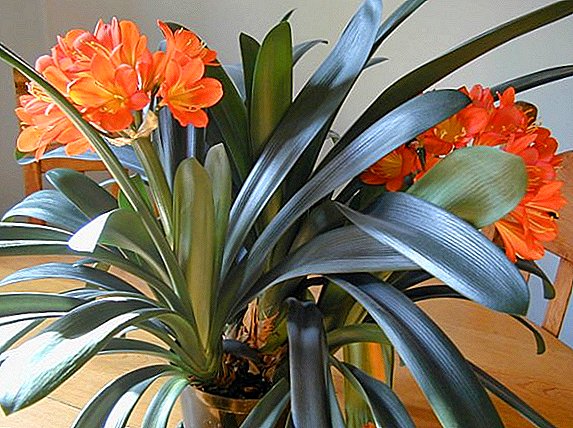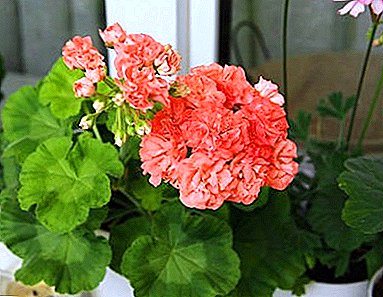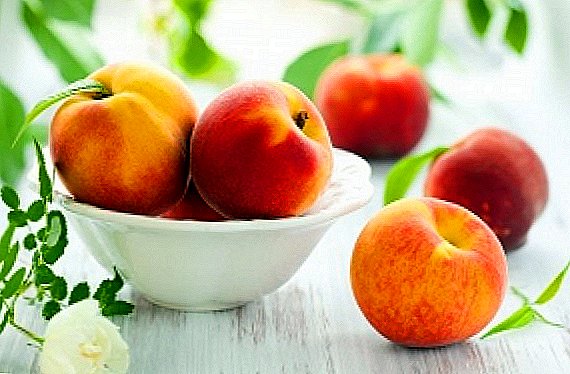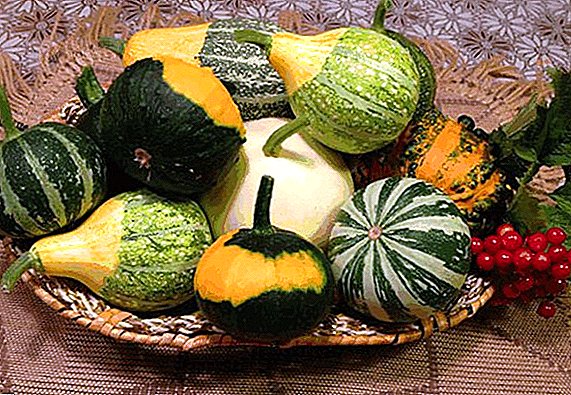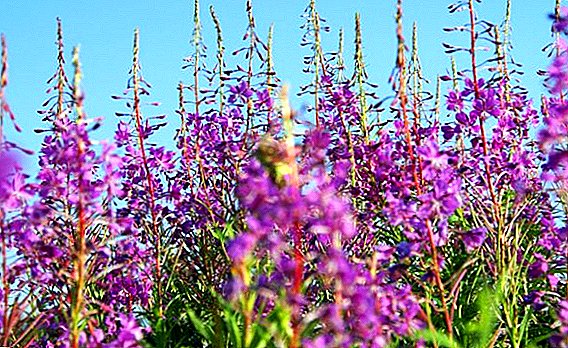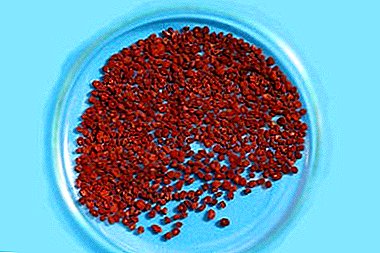
Breeding cyclamen at home is not easy, however, with the advent of new varieties and hybrids, difficulties have diminished. Hybrids are unpretentious, care for them is simple and easy.
The new hybrids include miniature varieties of cyclomen, of which make up spectacular mixes. Cyclamen mix is not a separate variety, but a trademark under which mixtures of cyclamen seeds, as a rule, of small size are marketed.
Homeland and history
Cyclamen is considered the birthplace of the Mediterranean coast. The first flowers cultivated in ancient times are descended from wild plants found in Cyprus and in Greece.
In Europe, cyclamens became popular at the end of the seventeenth century, and since then, many original varieties and hybrids have been bred in the world. The leading positions in the selection of cyclamens today are held by flower companies of the Netherlands, Germany, Italy, and France. It was in their laboratories that miniature hybrids were obtained that differ in the shape and color of flowers and leaves.
For cyclamen mix, plants derived from Persian cyclamen are usually selected., with large flowers and undersized bush. It is very rare to find mixes made up of hybrid forms of European (purple) cyclamen. When buying it is necessary to clarify what kind of flower was the basis for the flower mixture.
Botanical description
Cyclamen is a perennial herb. Him:
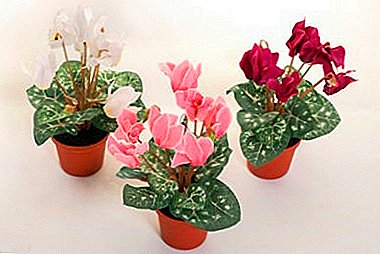 slightly flattened, spherical, tuberous tuber, growing in diameter up to 15 cm, with small root processes growing on the “bottom”, not forming daughter nodules (excluding European);
slightly flattened, spherical, tuberous tuber, growing in diameter up to 15 cm, with small root processes growing on the “bottom”, not forming daughter nodules (excluding European);- basal, leathery, dense, large (up to 14 cm), bluish-green leaves in the shape of an elongated heart or oval;
- on the outer side of the sheet plate is covered with silver-gray or golden-brown marble pattern, giving the plant additional decorativeness;
- in European species, the lower side of the leaf plate is purple;
- strong, tall, pinkish-brown flower stalks grow straight from the tuber;
- flowers in the form of a butterfly (3-12 cm) with elongated lanceolate slightly twisted, curved back petals;
- fruit-box with small seeds on a long curving stalk that descends to the soil as it ripens;
- blooms profuse, one plant capable of forming up to 100 flowers per season;
- the flowering period is long;
- during the rest period, the plant sheds leaves.
Most modern pot cultivars originate from the Persian cyclamen (C. persicum), belonging to the Cyclamen genus (Cyclamen), family of Primordias (Primulaceae).
Important! In European cyclamen flowering period occurs during the warm season. In winter, the flower is resting. In Persian, the rest comes in the summer.
Popular varieties
Many varieties have been bred with flowers of various shapes: large and small-flowered, with a simple and terry type of flower structure, corrugated or smooth petals of various colors - white, purple, purple, pink, purple, red, cherry, almost black. There is also a two-color coloring of the petals (flamed and picotee).
 Depending on the size, cyclamens are divided into 3 groups:
Depending on the size, cyclamens are divided into 3 groups:
- standard (maxi) up to 30 cm;
- medium tall (midi) - up to 22 cm;
- undersized (mini) - no higher than 15 cm.
Cyclamen mix is usually represented by a series (plants of the same variety of different colors) miniature plants. It is subdivided into a mini mix and patio mix, although you can find a medium and tall flower mixture composed of plants of different colors of one or several varieties.
Mini
Among the cyclamen mini popular series:
- Silver Heart.
- Midori.
- Winfall.
- Miracle.
- Libretto.
- Silverado.
- Jeanette.
- Silverhear.
- Super Verano.
- Snow slide.
- Microsorum.
They have rather large flowers, exceeding 4 cm in diameter.
Patio
 The patio mix cyclamen include the smallest plant up to 10 cm high:
The patio mix cyclamen include the smallest plant up to 10 cm high:
- Mirabelle.
- Puppet.
- Kaori.
- Tiny Mites.
Small-flowering plants, color palette from white to all shades of red, lilac, lilac. Flowering from September to March-April. Some hybrids do not hibernate and are able to bloom all year round with short breaks.
Description and photos of the most beautiful species of cyclamen can be found in this material.
Where and how to plant?
The rules of planting and keeping babies do not differ much from the rules of growing their tall relatives.
Process
When planting seeds adhere to the algorithm:
- untreated seeds are soaked in warm water for a day;
- decontaminated soil is poured into the seedling boxes or separate pots with a drainage layer;
- seeds are placed superficially, at a considerable distance from each other and sprinkled with a thin layer (5 mm) of soil or vermiculite;
- Seed boxes are placed in a dark place with a temperature not exceeding + 20 ºC;
- after the appearance of 2-3 true leaves, seedlings are seated in pots.
Lighting and location
The pots are set on the east, northeast, and west window, away from heating appliances. Do not allow the plant to direct sunlight, causing burns on the leaves.
Important! The plant does not tolerate gas pollution, dusty air, it is not necessary to place it in the kitchen, smoking rooms.
Soil requirements
 For proper development of the plant requires a well-drained neutral or weakly acidic soil with a pH of 5.5-6 acidity. Ready soils are suitable for geraniums, tomatoes, peppers (Terra Vitta, Florin, Klassman, Sturgeon).
For proper development of the plant requires a well-drained neutral or weakly acidic soil with a pH of 5.5-6 acidity. Ready soils are suitable for geraniums, tomatoes, peppers (Terra Vitta, Florin, Klassman, Sturgeon).
Soil mixture can be prepared independently using any of the recipes:
- equal parts of leaf and sod land, river sand, rotted humus;
- one part of sand, two parts of organic filler (peat, coconut fiber, humus).
Home care
Mix care doesn’t differ much from regular cyclamen care:
- Temperature. The plant requires a cool temperature of + 14-16 ° C. Miniature cyclamens in a too warm room can be installed, to create an optimal temperature, between the window frames.
- Watering. To protect the plants from rotting - spend "bottom" watering. For this purpose, a layer of peat is placed in a tray with water, on which a flower pot is placed so that it does not come into contact with water. During abundant flowering plants watered with water at room temperature 1 time in three days.In the period of leaf regrowth, the necessary moisture (50-60%) is maintained by spraying air around the pot. With the beginning of budding spraying stop.
- Crop. The leaves of cyclamen are not cut, and gently unscrew or wait until they fall off themselves. Peduncles with faded flowers are cut with a sharp sterile knife at the base.
- Feeding. In the phase of active growth and flowering, cyclamen is fed every two weeks with complex mineral fertilizers for flowering plants with a low nitrogen content (Agricola, Master, Biohumus, AVA).
- Care in a dormant period. After the end of flowering, watering is minimized, feeding is stopped. The pot is covered with a paper bell or cleaned in a dark, cool place.
- Transfer. With the appearance of small leaves on the tuber, the tuber is transplanted into a new pot with a diameter of 1-2 cm more than before.
Diseases and pests
Among the common diseases of cyclamen mix:
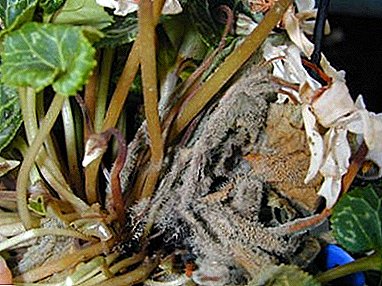 non-infectious rhizoctonia tuberous and gray rot;
non-infectious rhizoctonia tuberous and gray rot;- gall root nematodes;
- anthracnose;
- viral bronze leaves;
- ring mosaic;
- fusarium wilt;
- phytophlorosis.
Of the floral pests are the most dangerous:
- thrips;
- spider webs, cyclomenes, and claw mites;
- aphid;
- schitovka.
Important! Insecticides are used for pest control (Aktar, Actellic, Fufanon). With a strong infection, the diseased plant is destroyed.
Breeding methods
All cyclamens multiply by seeds and vegetatively, Persian - by dividing the tuber, European with the help of daughter klubashkov.
Seminal
When choosing a seed method, it should be taken into account that almost all cyclamen mix hybrids. Therefore, to get a flower with pronounced varietal characteristics of its own seeds will not work. Need to buy mixes in stores.
Tuber
Although this method is considered very traumatic, it gives good results and flowering occurs faster. The order is as follows:
- a tuber with several growth buds is dried;
- cut a piece of pulp with an eye;
- a cut is powdered with charcoal powder;
- planting material spread on the soil, not dropping left open;
- The drawer is placed in a dark place or covered with a dark covering material that is breathable.
When vegetative planting method especially closely monitor watering. At the slightest waterlogging, the cut rots and the plant dies.
Similar plants
Similar to cyclamen in terms of flowering and growing conditions of several indoor cultures.
Primrose
Low (25-30 cm) plant, with bright five-petal flowers blue, yellow, red, pink, white.

Poinsettia or Christmas star
The plant beauty is given by bright red bracts.

Azalea
Tall plant of the Rhododendron family.

Camellia
Evergreen shrub or small tree from the family of tea.

Snow beauty or hiondoks
A small graceful plant with leaves up to 12 cm long and peduncle up to 20 cm high.
Blooming in early spring.

Mix cyclamens are able to please the most demanding growers. With proper care, they will please the eyes of others, will deliver the owners a lot of pleasant minutes.


 slightly flattened, spherical, tuberous tuber, growing in diameter up to 15 cm, with small root processes growing on the “bottom”, not forming daughter nodules (excluding European);
slightly flattened, spherical, tuberous tuber, growing in diameter up to 15 cm, with small root processes growing on the “bottom”, not forming daughter nodules (excluding European); non-infectious rhizoctonia tuberous and gray rot;
non-infectious rhizoctonia tuberous and gray rot;